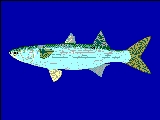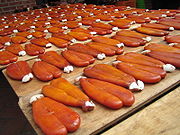
Flathead mullet
Encyclopedia
The flathead mullet, Mugil cephalus, is a mullet
of the genus Mugil
, found in coast
al tropical and subtropical waters worldwide. Its length is typically 30 to 75 centimeters (12 to 30 inches). This species
occurs worldwide, attested by other common names for this fish:
The Striped Mullet is a mainly diurnal coastal species that often enters estuaries and rivers. The Striped Mullet usually schools over sand or mud bottoms, feeding on zooplankton. The Adult fish normally feed on algae in fresh water. The maximum size the Striped Mullet may reach is approximately 120 cm, with a max weight of about 8,000 g. The species is euryhaline meaning that the fish can acclimate to different levels of salinity; this combined with the acclimation of juveniles to high water temperatures appears to be a selective advantage.
 The flathead mullet is an important food fish for many around the world, and can be both fished and farmed. The roe
The flathead mullet is an important food fish for many around the world, and can be both fished and farmed. The roe
of this mullet is salted, dried, and compressed to make a specialty food across the world, such as Taiwanese Wuyutsu, Korean myeongran
jeot, Japanese karasumi
, Italian bottarga
, and Egyptian batarekh. In Egypt, the fish itself is salted, dried, and pickled to make feseekh
.
On the coast of Northwest Florida and Alabama, this mullet, called the striped or black mullet, is often a specialty of seafood restaurants. Fried mullet is most popular, but smoked, baked, and canned mullet are also eaten. Local fishermen usually catch mullet in a castnet, though some use a hook. Mullet is a delicacy in this area and is most often consumed in the home. Mullet are usually fillet
ed, and the remaining frames
used for fish stock, used in chowders and stews. The mullet most commonly consumed in Florida however is the white mullet (mugil curema), because its preference for cleaner water gives it a cleaner and less muddy taste.
Mullet does not keep well after it is caught. If kept on ice it may remain edible for approximately 72 hours, after which it becomes nearly inedible. The sooner it can be eaten after being caught, the better.
Mullet (fish)
The mullets or grey mullets are a family and order of ray-finned fish found worldwide in coastal temperate and tropical waters, and in some species in fresh water. Mullets have served as an important source of food in Mediterranean Europe since Roman times...
of the genus Mugil
Mugil
Mugil is one genus among 17 genera containing all together about 80 species of ray-finned fish of the family Mugilidae commonly known as mullet...
, found in coast
Coast
A coastline or seashore is the area where land meets the sea or ocean. A precise line that can be called a coastline cannot be determined due to the dynamic nature of tides. The term "coastal zone" can be used instead, which is a spatial zone where interaction of the sea and land processes occurs...
al tropical and subtropical waters worldwide. Its length is typically 30 to 75 centimeters (12 to 30 inches). This species
Species
In biology, a species is one of the basic units of biological classification and a taxonomic rank. A species is often defined as a group of organisms capable of interbreeding and producing fertile offspring. While in many cases this definition is adequate, more precise or differing measures are...
occurs worldwide, attested by other common names for this fish:
- Black mullet - Cuba, US
- Bully mullet - Australia, Vietnam
- Callifaver mullet - Cuba, Netherlands Antilles, US
- Common grey mullet - UK
- Common mullet - Cuba, Netherlands Antilles, US
- Flathead grey mullet - India, Philippines, UK
- Flathead mullet - Europe, FAO, UN, Fishbase
- Grey mullet - Turkey , Australia, Taiwan, Cuba, Fiji, Hong Kong, Mauritius, Netherlands Antilles, New Zealand, Spain, Tonga, UK, US, Mediterranean, Egypt
- Hardgut mullet - Australia
- Mangrove mullet - Australia
- Sea mullet - Australia, Fiji, Papua New Guinea, UK
- Striped mullet - Australia, Cuba, Mexico, Russian Fed, UK, US, Hawaii
The Striped Mullet is a mainly diurnal coastal species that often enters estuaries and rivers. The Striped Mullet usually schools over sand or mud bottoms, feeding on zooplankton. The Adult fish normally feed on algae in fresh water. The maximum size the Striped Mullet may reach is approximately 120 cm, with a max weight of about 8,000 g. The species is euryhaline meaning that the fish can acclimate to different levels of salinity; this combined with the acclimation of juveniles to high water temperatures appears to be a selective advantage.
Description
The Striped Mullet have dark centers which give the appearance of a series (6-7) of dark horizontal stripes. The fish grow to lengths up to 60.0 cm (24 inches) with weights as high as 4.0 kg (8.5 pounds).Range
The Striped Mullet historically ranged far up the Colorado River to the vicinity of Blythe and up the Gila River to perhaps Tacna. Because of the dams and restricted flows to the Sea of Cortez, the range in Arizona is restricted to the Colorado River below Laguna Dam and the lower end of the Gila River when there is water present. The Striped Mullet are often abundant in the mainstream and lateral canals in the Gila River region.Habitat
The Striped Mullet normally occupies fresh, brackish and marine habitats in depths ranging between 0–120 m and with temperatures between 8-24°C. In the Colorado River mullet are pelagic in larger pools, sometimes moving into currents below dams, and generally occurring in small groups.Population Trends
The Striped Mullet populations are currently declining in Arizona, due to periods when the Colorado River does not reach the Sea of Cortez.Cuisine

Roe
Roe or hard roe is the fully ripe internal egg masses in the ovaries, or the released external egg masses of fish and certain marine animals, such as shrimp, scallop and sea urchins...
of this mullet is salted, dried, and compressed to make a specialty food across the world, such as Taiwanese Wuyutsu, Korean myeongran
Myeongran
In Korean cuisine Myeongran or Myeongran jeot is a jeotgal made with the roe of flathead mullet or pollock and seasoned with chili pepper powder. It is commonly served as a banchan, or small dish accompanying rice or as an ingredient for altang , a kind of jjigae...
jeot, Japanese karasumi
Karasumi
Karasumi , Romaji: karasumi; ) is a food product made by salting mullet roe and drying it by the sunlight. A theory suggests that it got its name from its resemblance to a block of sumi imported from China and used in shodo...
, Italian bottarga
Bottarga
Botargo, also called bottarga , poutargue or boutargue , botarga , batarekh or avgotaraho is a Mediterranean delicacy of cured fish roe....
, and Egyptian batarekh. In Egypt, the fish itself is salted, dried, and pickled to make feseekh
Feseekh
Fesikh is a traditional Egyptian fish dish consisting of fermented salted and dried gray mullet, of the mugil family, a saltwater fish that lives in both the Mediterranean and the Red Seas...
.
On the coast of Northwest Florida and Alabama, this mullet, called the striped or black mullet, is often a specialty of seafood restaurants. Fried mullet is most popular, but smoked, baked, and canned mullet are also eaten. Local fishermen usually catch mullet in a castnet, though some use a hook. Mullet is a delicacy in this area and is most often consumed in the home. Mullet are usually fillet
Fillet (cut)
A fillet is a cut or slice of boneless meat or fish.- Meat :In the case of beef, in the USA, the term most often refers to beef tenderloin, especially filet mignon.- Chicken :...
ed, and the remaining frames
Fillet (cut)
A fillet is a cut or slice of boneless meat or fish.- Meat :In the case of beef, in the USA, the term most often refers to beef tenderloin, especially filet mignon.- Chicken :...
used for fish stock, used in chowders and stews. The mullet most commonly consumed in Florida however is the white mullet (mugil curema), because its preference for cleaner water gives it a cleaner and less muddy taste.
Mullet does not keep well after it is caught. If kept on ice it may remain edible for approximately 72 hours, after which it becomes nearly inedible. The sooner it can be eaten after being caught, the better.

